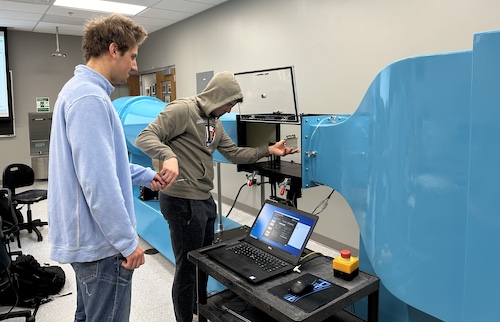Physics and Engineering Department
- Programs
- Program Curriculum
- Student Experiences
- Inside the Classroom
- Inside the Labs
- Department Newsletters
- Student Clubs
- Faculty/Contact Us
Mechanical Engineering
Contact Us:
- Department of Physics & Engineering
- Scranton, PA 18510
- The University of Scranton
- Scranton, PA 18510
- The University of Scranton
- Phone: +1 (570)-941-7509
- Fax: +1 (570)-941-4085
The Curriculum
The 137-credit curriculum offers 101 credits from the major and cognate courses, along with several electives.
Students can design a program of study to fit their individual career goals and aspiration.
Students who choose to complete the B.S. program in the traditional form will take the following major courses, many of which are paired with hands-on lab sessions:
- Computer Aided Design I & II
- Statics

- Dynamics
- Mechanics of Materials (with Labs)
- Materials Engineering
- Manufacturing Processes (with Labs)
- Thermodynamics
- Fluid Mechanics (with Labs)
- Heat Transfer (with Labs)
- Measurement and Instrumentations (with Labs)
- Machine Design
- Control Systems (with Labs)
- Mechanical Vibrations (with Labs)
- Senior Design I & II
Putting Theory into Practice
While completing the course curriculum, you'll complete design projects and assignments. You will also receive the support necessary to land internships during your studies.
Most importantly, you'll get to design parts made through:
- Injection molding
- Machining (Milling, Turning, and Grinding)
- 3D printing
- Metal casting
- Welding
- Metal bending and sheet metal forming
You'll get to test your skills in:
- Reverse engineering of machine components
- 2D and 3D design of mechanical systems
- Designing mating components considering GD&T and readily available mechanical fasteners
- Market opportunity identification
- Development of Specifications based on stakeholder interviews and market research
- Prototype design and production based on technical specifications
- Computer-aided engineering in design (CAD), analysis (CAE) and manufacturing (CAM)
- Modeling, simulation, analysis, evaluation, design, and optimization of engineering systems
- Design of thermal, fluids, and energy systems
You'll get to familiarize yourself with:
- Sensors such as strain gauges, pressure transducers, and load cells
- Data acquisition systems
- Uncertainty analysis and uncertainty propagation
- Dynamics capabilities and responses of various systems
- Sampling and filtering of data
Finally, during senior year you will get to apply majority of these skills in a hands-on project of your choosing where you would take on all the responsibilities of engineering design process including but not limited to project management, teamwork, market research, and all the technical aspects of the project.






